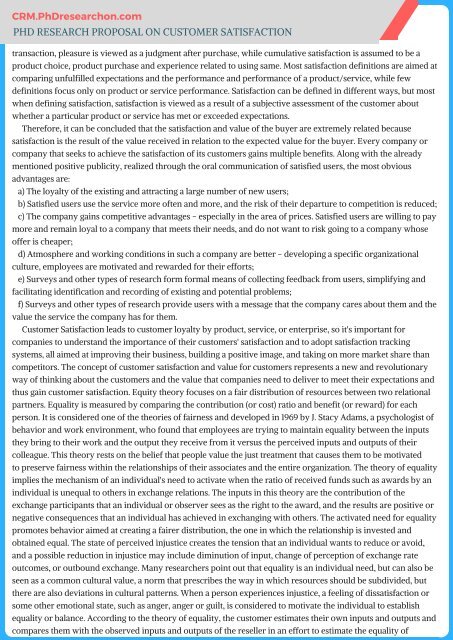PhD Research Proposal on Customer Satisfaction Sample
Hi! If you need a phd research proposal on customer satisfaction sample, take a look at this one. For more samples visit http://crm.phdresearchon.com/
Hi! If you need a phd research proposal on customer satisfaction sample, take a look at this one. For more samples visit http://crm.phdresearchon.com/
Create successful ePaper yourself
Turn your PDF publications into a flip-book with our unique Google optimized e-Paper software.
CRM.<str<strong>on</strong>g>PhD</str<strong>on</strong>g>research<strong>on</strong>.com<br />
PHD RESEARCH PROPOSAL ON CUSTOMER SATISFACTION<br />
transacti<strong>on</strong>, pleasure is viewed as a judgment after purchase, while cumulative satisfacti<strong>on</strong> is assumed to be a<br />
product choice, product purchase and experience related to using same. Most satisfacti<strong>on</strong> definiti<strong>on</strong>s are aimed at<br />
comparing unfulfilled expectati<strong>on</strong>s and the performance and performance of a product/service, while few<br />
definiti<strong>on</strong>s focus <strong>on</strong>ly <strong>on</strong> product or service performance. Satisfacti<strong>on</strong> can be defined in different ways, but most<br />
when defining satisfacti<strong>on</strong>, satisfacti<strong>on</strong> is viewed as a result of a subjective assessment of the customer about<br />
whether a particular product or service has met or exceeded expectati<strong>on</strong>s.<br />
Therefore, it can be c<strong>on</strong>cluded that the satisfacti<strong>on</strong> and value of the buyer are extremely related because<br />
satisfacti<strong>on</strong> is the result of the value received in relati<strong>on</strong> to the expected value for the buyer. Every company or<br />
company that seeks to achieve the satisfacti<strong>on</strong> of its customers gains multiple benefits. Al<strong>on</strong>g with the already<br />
menti<strong>on</strong>ed positive publicity, realized through the oral communicati<strong>on</strong> of satisfied users, the most obvious<br />
advantages are:<br />
a) The loyalty of the existing and attracting a large number of new users;<br />
b) Satisfied users use the service more often and more, and the risk of their departure to competiti<strong>on</strong> is reduced;<br />
c) The company gains competitive advantages - especially in the area of prices. Satisfied users are willing to pay<br />
more and remain loyal to a company that meets their needs, and do not want to risk going to a company whose<br />
offer is cheaper;<br />
d) Atmosphere and working c<strong>on</strong>diti<strong>on</strong>s in such a company are better - developing a specific organizati<strong>on</strong>al<br />
culture, employees are motivated and rewarded for their efforts;<br />
e) Surveys and other types of research form formal means of collecting feedback from users, simplifying and<br />
facilitating identificati<strong>on</strong> and recording of existing and potential problems;<br />
f) Surveys and other types of research provide users with a message that the company cares about them and the<br />
value the service the company has for them.<br />
<strong>Customer</strong> Satisfacti<strong>on</strong> leads to customer loyalty by product, service, or enterprise, so it's important for<br />
companies to understand the importance of their customers' satisfacti<strong>on</strong> and to adopt satisfacti<strong>on</strong> tracking<br />
systems, all aimed at improving their business, building a positive image, and taking <strong>on</strong> more market share than<br />
competitors. The c<strong>on</strong>cept of customer satisfacti<strong>on</strong> and value for customers represents a new and revoluti<strong>on</strong>ary<br />
way of thinking about the customers and the value that companies need to deliver to meet their expectati<strong>on</strong>s and<br />
thus gain customer satisfacti<strong>on</strong>. Equity theory focuses <strong>on</strong> a fair distributi<strong>on</strong> of resources between two relati<strong>on</strong>al<br />
partners. Equality is measured by comparing the c<strong>on</strong>tributi<strong>on</strong> (or cost) ratio and benefit (or reward) for each<br />
pers<strong>on</strong>. It is c<strong>on</strong>sidered <strong>on</strong>e of the theories of fairness and developed in 1969 by J. Stacy Adams, a psychologist of<br />
behavior and work envir<strong>on</strong>ment, who found that employees are trying to maintain equality between the inputs<br />
they bring to their work and the output they receive from it versus the perceived inputs and outputs of their<br />
colleague. This theory rests <strong>on</strong> the belief that people value the just treatment that causes them to be motivated<br />
to preserve fairness within the relati<strong>on</strong>ships of their associates and the entire organizati<strong>on</strong>. The theory of equality<br />
implies the mechanism of an individual's need to activate when the ratio of received funds such as awards by an<br />
individual is unequal to others in exchange relati<strong>on</strong>s. The inputs in this theory are the c<strong>on</strong>tributi<strong>on</strong> of the<br />
exchange participants that an individual or observer sees as the right to the award, and the results are positive or<br />
negative c<strong>on</strong>sequences that an individual has achieved in exchanging with others. The activated need for equality<br />
promotes behavior aimed at creating a fairer distributi<strong>on</strong>, the <strong>on</strong>e in which the relati<strong>on</strong>ship is invested and<br />
obtained equal. The state of perceived injustice creates the tensi<strong>on</strong> that an individual wants to reduce or avoid,<br />
and a possible reducti<strong>on</strong> in injustice may include diminuti<strong>on</strong> of input, change of percepti<strong>on</strong> of exchange rate<br />
outcomes, or outbound exchange. Many researchers point out that equality is an individual need, but can also be<br />
seen as a comm<strong>on</strong> cultural value, a norm that prescribes the way in which resources should be subdivided, but<br />
there are also deviati<strong>on</strong>s in cultural patterns. When a pers<strong>on</strong> experiences injustice, a feeling of dissatisfacti<strong>on</strong> or<br />
some other emoti<strong>on</strong>al state, such as anger, anger or guilt, is c<strong>on</strong>sidered to motivate the individual to establish<br />
equality or balance. According to the theory of equality, the customer estimates their own inputs and outputs and<br />
compares them with the observed inputs and outputs of the reseller in an effort to estimate the equality of



